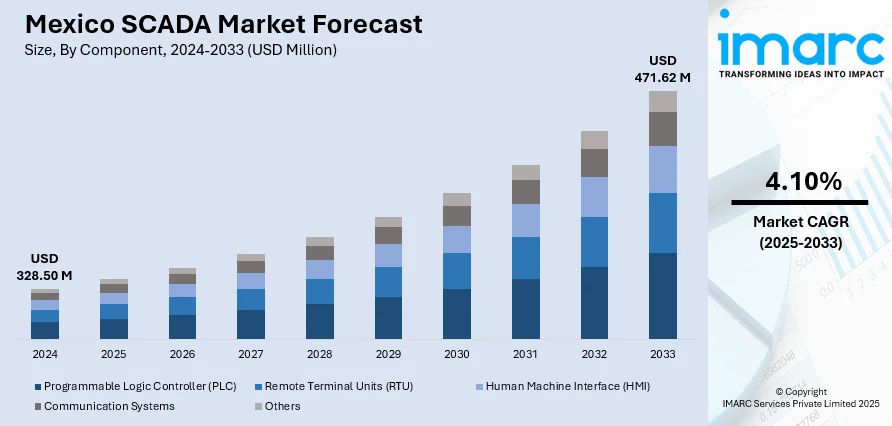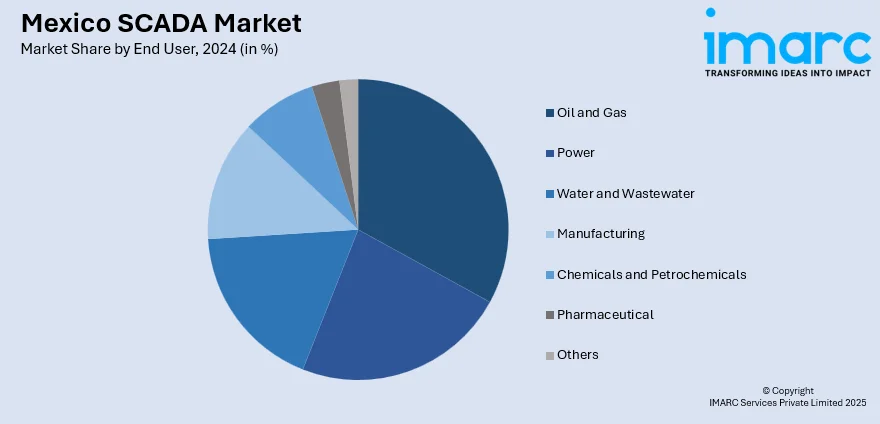
Mexico SCADA Market Size, Share, Trends and Forecast by Component, Architecture, End User, and Region, 2025-2033
Mexico SCADA Market Overview:
The Mexico SCADA market size reached USD 328.50 Million in 2024. Looking forward, IMARC Group expects the market to reach USD 471.62 Million by 2033, exhibiting a growth rate (CAGR) of 4.10% during 2025-2033. The market is witnessing significant growth due to rising automation in energy, water, and manufacturing sectors. Additionally, cloud integration, smart grid development, and real-time monitoring needs are driving SCADA adoption. Moreover, the increasing cybersecurity measures and IoT connectivity, regional infrastructure projects and industrial modernization are some of the other factors contributing to Mexico SCADA market share.
|
Report Attribute
|
Key Statistics
|
|---|---|
|
Base Year
|
2024 |
|
Forecast Years
|
2025-2033
|
|
Historical Years
|
2019-2024
|
| Market Size in 2024 | USD 328.50 Million |
| Market Forecast in 2033 | USD 471.62 Million |
| Market Growth Rate 2025-2033 | 4.10% |
Mexico SCADA Market Trends:
Rising Demand in Industrial Automation
Mexico's industrial sectors, particularly oil & gas, power generation, and water utilities, are experiencing a significant shift toward automation to improve operational efficiency and minimize downtime. For instance, in August 2024, reports highlighted a $19.992 billion investment by CFE in electricity infrastructure over six years, averaging $55.5 billion pesos annually. This funded 35 generation projects, and 60 transmission and 41 distribution projects. In 2023, 5 transmission and 17 distribution projects were completed, ensuring electricity demand is reliably met. SCADA technologies are at the forefront of this change by supporting real-time monitoring, control, and data acquisition in complex infrastructure networks. In oil and gas, SCADA is used for pipeline monitoring, pressure management, and leak detection. In the power industry, it protects against grid instability and fault isolation. For water utilities, SCADA enables flow control, treatment plant monitoring, and remote troubleshooting. The need for affordable, data-intensive operations is forcing business houses to embrace SCADA solutions that can integrate well with their current machines and provide actionable intelligence. As industrial facilities grow in size and complexity, the reliance on SCADA systems continues to rise, supporting the broader automation trend and strengthening Mexico SCADA market growth.

Smart Grid Expansion
Mexico's push toward modernizing its electrical infrastructure is driving major investments in smart grid projects across the country. For instance, in November 2024, Mexico's government unveiled a US$23 billion National Strategy for the Electricity Sector (2024-2030) focused on the Federal Electricity Commission (CFE). The plan allocates US$12.3 billion for new generation (13,024 MW), US$7.5 billion for transmission, and US$3.6 billion for distribution, aiming to enhance infrastructure and investment opportunities. These initiatives aim to improve grid reliability, enable real-time load balancing, and reduce power outages. SCADA systems are central to this transformation, offering utilities the ability to monitor and control grid components remotely, detect faults instantly, and automate recovery processes. With growing energy demand and a need for sustainable energy integration, utilities are turning to SCADA for efficient distribution management and to support renewable energy sources like solar and wind. Additionally, SCADA platforms provide granular visibility into grid performance, enabling predictive maintenance and optimized energy dispatch. As the country advances toward a more resilient and intelligent power infrastructure, the implementation of SCADA systems is becoming essential, directly contributing to market growth.
Mexico SCADA Market Segmentation:
IMARC Group provides an analysis of the key trends in each segment of the market, along with forecasts at the country and regional levels for 2025-2033. Our report has categorized the market based on component, architecture, and end user.
Component Insights:
- Programmable Logic Controller (PLC)
- Remote Terminal Units (RTU)
- Human Machine Interface (HMI)
- Communication Systems
- Others
The report has provided a detailed breakup and analysis of the market based on the component. This includes programmable logic controller (PLC), remote terminal units (RTU), human machine interface (HMI), communication systems, and others.
Architecture Insights:
- Hardware
- Software
- Services
A detailed breakup and analysis of the market based on the architecture have also been provided in the report. This includes hardware, software, and services.
End User Insights:

- Oil and Gas
- Power
- Water and Wastewater
- Manufacturing
- Chemicals and Petrochemicals
- Pharmaceutical
- Others
A detailed breakup and analysis of the market based on the end user have also been provided in the report. This includes oil and gas, power, water and wastewater, manufacturing, chemicals and petrochemicals, pharmaceutical, and others.
Regional Insights:
- Northern Mexico
- Central Mexico
- Southern Mexico
- Others
The report has also provided a comprehensive analysis of all the major regional markets, which include Northern Mexico, Central Mexico, Southern Mexico, and others.
Competitive Landscape:
The market research report has also provided a comprehensive analysis of the competitive landscape. Competitive analysis such as market structure, key player positioning, top winning strategies, competitive dashboard, and company evaluation quadrant has been covered in the report. Also, detailed profiles of all major companies have been provided.
Mexico SCADA Market Report Coverage:
| Report Features | Details |
|---|---|
| Base Year of the Analysis | 2024 |
| Historical Period | 2019-2024 |
| Forecast Period | 2025-2033 |
| Units | Million USD |
| Scope of the Report |
Exploration of Historical Trends and Market Outlook, Industry Catalysts and Challenges, Segment-Wise Historical and Future Market Assessment:
|
| Components Covered | Programmable Logic Controller (PLC), Remote Terminal Units (RTU), Human Machine Interface (HMI), Communication Systems, Others |
| Architectures Covered | Hardware, Software, Services |
| End Users Covered | Oil and Gas, Power, Water and Wastewater, Manufacturing, Chemicals and Petrochemicals, Pharmaceutical, Others |
| Regions Covered | Northern Mexico, Central Mexico, Southern Mexico, Others |
| Customization Scope | 10% Free Customization |
| Post-Sale Analyst Support | 10-12 Weeks |
| Delivery Format | PDF and Excel through Email (We can also provide the editable version of the report in PPT/Word format on special request) |
Key Questions Answered in This Report:
- How has the Mexico SCADA market performed so far and how will it perform in the coming years?
- What is the breakup of the Mexico SCADA market on the basis of component?
- What is the breakup of the Mexico SCADA market on the basis of architecture?
- What is the breakup of the Mexico SCADA market on the basis of end user?
- What is the breakup of the Mexico SCADA market on the basis of region?
- What are the various stages in the value chain of the Mexico SCADA market?
- What are the key driving factors and challenges in the Mexico SCADA market?
- What is the structure of the Mexico SCADA market and who are the key players?
- What is the degree of competition in the Mexico SCADA market?
Key Benefits for Stakeholders:
- IMARC’s industry report offers a comprehensive quantitative analysis of various market segments, historical and current market trends, market forecasts, and dynamics of the Mexico SCADA market from 2019-2033.
- The research report provides the latest information on the market drivers, challenges, and opportunities in the Mexico SCADA market.
- Porter's five forces analysis assist stakeholders in assessing the impact of new entrants, competitive rivalry, supplier power, buyer power, and the threat of substitution. It helps stakeholders to analyze the level of competition within the Mexico SCADA industry and its attractiveness.
- Competitive landscape allows stakeholders to understand their competitive environment and provides an insight into the current positions of key players in the market.
Need more help?
- Speak to our experienced analysts for insights on the current market scenarios.
- Include additional segments and countries to customize the report as per your requirement.
- Gain an unparalleled competitive advantage in your domain by understanding how to utilize the report and positively impacting your operations and revenue.
- For further assistance, please connect with our analysts.
 Request Customization
Request Customization
 Speak to an Analyst
Speak to an Analyst
 Request Brochure
Request Brochure
 Inquire Before Buying
Inquire Before Buying




.webp)




.webp)












